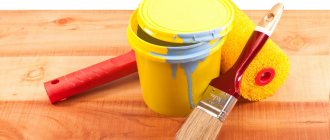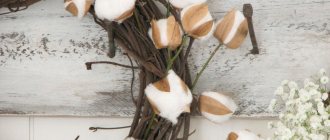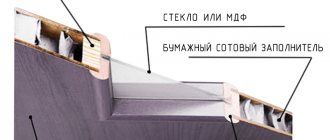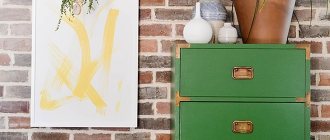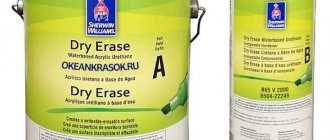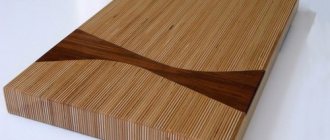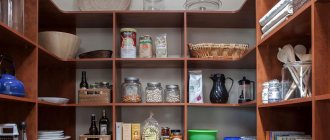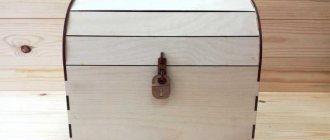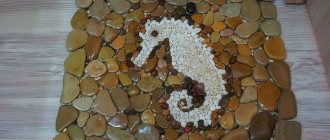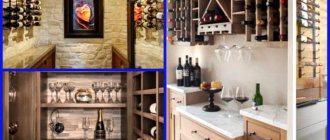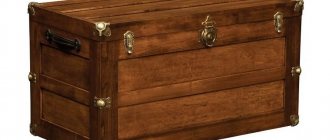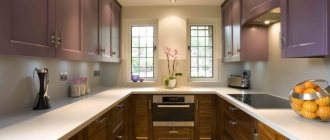Painting plywood is considered a necessary measure to protect the material from excessive moisture or other harmful environmental influences.
Currently, plywood is still often used in construction, especially private construction. It is made from thin sheets of veneer, which are glued together with adhesives of various compositions. It is used for the production of furniture, wall coverings, floors, as well as finishing the facades of buildings.
Why is plywood so popular? Durability and environmental friendliness are the main advantages of this type of building materials.
But it’s not enough to just purchase plywood and use it in its pure form for your needs. It is necessary to apply a number of measures thanks to which the plywood board can last a long time. And one of these measures is painting.
Let's look at each stage of painting plywood in more detail.
Water-based acrylic paint
If the building material will be installed in a residential building (apartment), then you can take a closer look at water-based paints, which are suitable for interior decoration.
The use of acrylic paint is widespread: it is environmentally friendly, easy to handle, quite durable, and also allows the use of a wide range of shades. The paint is applied to the plywood in two layers, and both sides and ends are treated. If there is no active mechanical impact on the sheets, then the choice can be made in favor of conventional water-based paint.
Processing plywood before painting
Before painting, plywood must be completely cleaned of dust and small sawdust. Plywood sheets should be painted along the wood grain.
Do not forget that before preparing plywood for painting and staining, the sheet must dry thoroughly. Everyone knows the property of this material - to warp.
You can avoid the risk of deformation by simply keeping the sheets in a dry room at room temperature for 3-4 days. This is especially true if the material was stored on the street or in a damp construction warehouse. Experts recommend not neglecting this stage and keeping the material for several days in the room where you then plan to paint it.
Initially, the sheet must be sanded to remove any irregularities.
This stage can only be avoided if you purchase high-grade material. It's already quite high quality. For cheap varieties, sanding is highly desirable.
First, use coarse-grained sandpaper (No. 80-100), and then use medium-grained sandpaper (No. 100-120). This improves the subsequent adhesion of the surface to the paint. Do not forget to process the edges of the sheets; if they are too rough, they can be lightly planed and then sanded.
If you need to hide joints, fasteners or very noticeable defects, use putty. This material will also be useful to you if you decide to glue wallpaper onto plywood. Don't forget to sand the putty areas
After grinding is completed, the surface must be primed; most often, drying oil, primers with an alkyd base, or special compounds that fill the pores of the material are used for this.
For large volumes of work, it is recommended to use electric grinders. They will save time, make work easier and improve its quality.
Cleaning and sanding the material
When purchasing raw materials, you should pay attention to its texture: if it is very rough, the material must be cleaned and sanded. Before painting the plywood yourself, experts recommend drying it. Most likely, the sheets of material were sold from a warehouse, and it was often humid and damp there, so the wood could absorb some of the moisture. It is not possible to dry the product quickly, so the sheets of material are sent to a dry and warm place for 3 days.
With this tool you can sand small surfaces. If the sheets of material are large, it is better to use a power tool.
Once the plywood has dried, you can begin preparing it:
- Cleaning. This simple process is carried out to ensure that no large specks or contaminants remain on the surface of the raw material. Plywood can absorb moisture, so do not use water when cleaning. High-quality wood will always have a distinctive pattern - you also need to walk over it and check for contamination. Dirt must be removed using a coarse brush.
- Sanding. This procedure requires perseverance and care. Sanding consists of two stages: the first involves sanding with coarse-grain sandpaper, and the second with fine-grain sandpaper. The important thing here is to achieve not beauty, but a smooth surface. According to the advice of the masters, it is better to use a special grinding machine - this will speed up the work.
After passing coarse grain across the surface, it is necessary to change the nozzle to paper with fine dispersion. This procedure can easily be carried out manually, but it will take more time. Don't forget about the edges of the product - they also need to be cleaned and sanded.
Varnishing plywood
What is a primer used for?
If finishing with plywood sheets is done indoors, then due to fluctuations in temperature and humidity, the wood texture may change: shrink and expand. The primer as an intermediate layer will not allow the applied paint to crack and will protect the base from moisture penetration and the formation of fungus. The primer is applied with a roller.
It is necessary to allow the soil to dry, and then additionally treat the plywood with antiseptics and fire retardants, which will enhance protection against fire and prevent blue stains from appearing. This is one of the important elements of the preparation process if you are going to paint plywood with transparent paint that has low resistance to bioaggressive manifestations.
Are all steps necessary?
Most craftsmen, when processing large areas of plywood, greatly simplify the process, limiting themselves to sanding, priming and subsequent painting. Putty is used only in case of major damage. Preparation of the plywood base before painting ensures:
- additional strength;
- moisture resistance;
- beautiful smooth surface;
- longer possibility of using the product.
In addition, putty and primer are cheap and significantly help reduce paint consumption. The plywood base is very porous, has many voids, and the soil will fill them. If there is no soil, then the voids will be filled with dye, which is more expensive and cannot greatly increase strength.
How to paint plywood
Painting plywood correctly is not difficult. We have already talked about applying paint according to the arrangement of the fibers. You can also take a completely traditional tool: a roller, sprayer or paint brush.
Let's consider in which case it is more appropriate to choose each of these options:
Ideal for saving time and large amounts of space, such as floors, ceilings, facades;
Convenient for painting medium-sized areas, such as a plywood cabinet, for example. As for the material of the roller coat, it is better to choose foam rubber for plywood;
A universal tool that can be found in every home. Ideally paints hard-to-reach places (corners), ends and shaped elements.
Applying varnish
Sometimes varnish is used instead of paint. The plywood is first cleaned and sanded using sandpaper or a sanding machine, then it must be cleaned of any accumulated dust and degreased. Otherwise, all dirt will be visible under the varnish.
After applying the first layer of varnish, let it dry. Sand the first layer and then cover the surface with another layer. As a result of this approach, varnished plywood becomes dull.
If you want to get a glossy surface, you need to apply another layer of varnish on top. This time it is advisable to apply it using a sprayer to evenly distribute the varnish composition.
Decorative painting
The following methods exist:
- Texture selection. The technology is suitable for slabs with a pronounced texture. The simplest option is to tint the surface with stain. You can also use wax, which is applied and rubbed in a certain sequence.
- Antique processing. To do this, the plywood is painted in a dark color, a primer and a solution of a lighter shade are laid on top, after which the coating is rubbed down with sandpaper. An alternative option involves the use of patating compounds.
- Creating patterns. To do this, the surface must be painted in a single color, and then decorated with the desired pattern.
You can use your imagination when working, but it is important not to forget about the existing nuances.
Wood painting
To paint plywood to look like wood, you can use different shades of stain. If you need a glossy surface, apply an additional layer of varnish on top.
Plywood boards are problematic materials in terms of painting. This is due to the specific texture of the surface, which does not allow for even laying of the paint and varnish composition. Such problems arise with many wood-based materials, but painting plywood is complicated by the presence of pronounced roughness and even burrs on the outside of the board.
Features of painting work with plywood sheets
Paint and varnish coatings are reluctant to apply to plywood, which is due to the uneven surface. This applies to a greater extent to materials that have undergone rough factory processing.
Therefore, preparatory activities occupy a special place in this matter. It is not recommended to apply the composition directly to a wood base, as there is a risk of getting a defective coating with obvious defects. Even if you treat the surface with a thick layer, cracks and warping of the paint will appear in the future.
Therefore, painting plywood should be done in several layers, and the base coats are not decorative. They perform the functions of priming and leveling - that is, they prepare the base for applying a full-fledged decorative layer. In some cases, special mechanical processing of the sheets is required so that the primer itself can be laid on them.
Painting methods
Methods for refining plywood differ in both technical tools and the type of paint composition used.
As for tools, a regular brush, a roller, and a spray gun can be used. The highest quality results are achieved with the last tool. A pneumatic spray gun allows you to provide an even coating of paint and varnish.
In this case, the base layers can also be done with a brush - at this stage, maintaining a uniform layer is not so significant. In terms of choosing a coloring agent, everything is not so clear. If emphasis is required on aesthetic value, then, undoubtedly, preference should be given to construction paints - for example, acrylic or pentaphthalic compositions of the desired shade are suitable.
Painting plywood with varnish is also practiced, which involves a traditional set of tools - from a brush to a spatula. The treatment is carried out in several layers with long strokes. There are also special products for bleaching wood, which are also suitable for plywood.
They contain chlorine, sodium or potassium hypochlorites, lime, etc. It is advisable to use this option when working with plywood that is part of the structure of utility premises, rather than residential ones.
Preparation begins with thorough cleaning of the surface. It is necessary to remove both debris and dust, and weak damaged areas of the sheet. Next, you can grind the material. If plywood is being prepared for painting with varnish or the same acrylic paint, then this operation will be mandatory.
A machine with polishing abrasives will remove burrs, loose fragments and simply provide a smooth base. The second stage of preparation will be to create a reliable base for applying a decorative paint layer. For this purpose, primer putty on plywood for painting can be used, which contains strengthening and adhesive components. If you plan to use plywood outdoors, then it would be useful to include water- and frost-resistant additives in the primer.
Painting plywood outdoors
For external work, it is necessary to select solutions taking into account the constant adverse effects. The type of slabs used is also important. The fact is that moisture-resistant products most often only need finishing, while sheets that do not have such parameters must undergo a full range of protective cladding.
Exterior plywood paints:
- Alkyd enamels. An excellent solution for wood surfaces, it creates a glossy finish that is resistant to temperature changes. A significant drawback is gradual fading and an unpleasant odor.
- Oil solutions. They belong to the covering varieties. Due to the toxicity, the work is carried out using a special technology. The resulting coating has low resistance to weathering and ultraviolet radiation.
- Acrylic mixtures. For outdoor events, it is better to use options with a special mark. The elasticity and vapor permeability of the film avoid deformation during seasonal climatic fluctuations. The surface retains color saturation for a long time.
Alkyd compositions are considered the most durable, acrylics have the widest range of colors, and oil paints are considered a budget option.
When working outdoors, it is important to pay attention to the ends of the products, since it is through them that moisture penetrates. For protection, treatment is carried out with adhesion-increasing compounds and antiseptics. The edges facing the ground can be covered with a special mastic.
Preparing tools and paint
In addition to the main painting tools, which must be thoroughly cleaned, auxiliary devices should be prepared. These will include the same trowel, a construction knife and equipment for supplying compressed air if you plan to use a pneumatic sprayer.
Next, the paint and varnish composition is prepared. Initially, it can be a liquid solution or a dry mixture. In both cases, thorough stirring and dilution with water is required.
It is important to consider that painting plywood will be of high quality only if the solution is uniform. It should be free of lumps and foreign bodies. If necessary, at this stage you can add modifiers to the composition that improve certain qualities of the mixture.
Instructions for applying the composition
If the choice falls on a brush or roller, then the actions should be performed smoothly and without jerking. It is recommended to cover as large an area as possible in one pass, which will minimize smudges and make the coating uniform. At the same time, it is better not to limit yourself to one layer - on average, this design is performed in 2-3 passes.
If you are preparing to paint a plywood floor, you should count on 5-6 layers, since this coating will require increased mechanical resistance. The easiest way to work is with a spray gun. It sprays the composition evenly over the entire area and the user can only monitor the abundance of coverage. In this case, leaks are also possible, but this effect can be avoided if you perform intensive movements of the working head of the tool.
Recommendations as you work
When working with a roller, it is important to monitor its pile. Fur models of this tool leave hairs that will be difficult to remove in the future without disturbing the structure of the coating. Therefore, initially it is better to use a foam roller.
If you plan to work with a heterogeneous structure that has complex areas and large flat areas, then it is advisable to combine tools. For example, painting plywood with a brush will be the optimal solution for working with corners, edges and curved elements. It is better to process a large, flat surface with a pneumatic tool. The direction of the tool at the time of movement should be longitudinal relative to the wood fibers - such a scheme for applying the paint and varnish material will ensure strong fixation of the coating, and will also allow the shade to be preserved for a long time.
Preparing for painting
You can extend the life of the base by painting it. Before painting plywood, it is necessary to prepare its surface for applying the coloring composition. The purpose of preparation is to achieve maximum smoothness and evenness of the surface.
Painting plywood is done in stages.
First you need to sand it with #80 sandpaper. After this, an acrylic-based primer is applied and left until completely dry. Wood putty, made on the basis of acrylic, is applied to the dried primer, just like the primer.
The leveling layer must also dry completely. After drying, it is sanded with sandpaper No. 80-120. The surface is again primed, dried and painted.
Characteristics of plywood.
Primer is used to protect the base from fungus.
The primer is applied with a roller. You don’t have to do any leveling if there are no special requirements for its relief. In this case, the material is primed and painted.
Grinding allows you to remove uneven surfaces and prepare it for further processing. You need to make sanding movements perpendicular to the direction of the wood grain.
If further processing involves opening with varnish, then you will also need to sand along the wood grain with fine-grained sandpaper. The edges of the material can be slightly planed towards the center. They are covered with 2-3 layers of acrylic paint.
The surface is primed and puttied for the following purposes:
- leveling the surface capable of absorption; filling cracks on the inner surface of the veneer; extending the service life of the material; protection from damage.
Tips and tricks
To get the best result, it is advisable to consider some rules:
- Using preparation and painting compounds that have an identical base increases durability and reliability.
- For saturation, the mixture is applied in a thin layer.
- If the plywood has a lot of knots, they are impregnated separately with a large amount of solution. Each end is prepared in the same way.
- High-quality grinding eliminates roughness and improves the appearance of the coating.
- To obtain a deep gloss and additional protection, 2-3 layers of varnish are applied to the paint.
If you follow the technology and take into account the recommendations, the result will meet your expectations.
How and with what to paint plywood?
The choice of coloring composition and dyeing method directly depends on the purpose of the material.
The main purpose of painting is to prevent cracking of the material. If plywood will be laid on the floor in a room with high humidity, then it is necessary to coat it with paint on both sides, and treat the edges especially carefully; several layers of the composition must be applied to them.
Plywood painting scheme.
How to paint plywood depends on the location of the work.
If this is a residential area, then it is recommended to choose water-based compositions. Acrylic is good in this case. It is applied easily to the prepared surface and dries quickly, and has almost no unpleasant odor.
If the material will be used outdoors, then the best option is pentaphthalic paint, which is a regular enamel coating for wooden surfaces. The composition is easy to apply and dries quickly.
You can purchase a ready-made composition, but if you wish, you can stay with the basic version and color the composition yourself. Before painting plywood, you need to make sure that it does not have excessive moisture. If the material was stored in conditions of high humidity, it must be dried before processing to normal humidity.
To create an attractive glossy surface, the plywood floor can be additionally varnished. This is not necessary if glossy paint is used. The paint on the surface of the material must be completely dry.
It is very important to decide in advance what to paint the plywood on the floor with. The best option is a sprayer.
With its help you can achieve uniform coverage. You can use a roller, but only without lint, but with foam rubber. If necessary, paint hard-to-reach areas using a brush.
Thus, before painting plywood, it must be prepared for the application of the coloring composition. To cover the base, certain compositions are selected. Processing methods depend on the purpose of the material.
Plywood is used quite often in modern construction and renovation, so painting plywood is a very pressing issue. The peculiarity of this material is in the method of its production.
To make it, thin sheets of veneer are glued together. The adhesive used determines the characteristics of the material, for example, its moisture resistance. Depending on the degree of resistance to moisture, plywood can be regular, moisture-resistant or laminated.
Painting helps protect plywood from rotting and moisture, and also extends its service life.
Painting the surface of a plywood sheet
Type of paint. For interior work, it is preferable to use water-based paint. As the name suggests, water is used as a solvent, so water-based paint is odorless, durable and harmless to health.
A wide selection of concentrated colors allows you to get any color; you just need to add the required amount of color concentrate to the white paint and mix thoroughly.
The outside of plywood is painted with pentaphthalic enamel. The enamel is easy to use, has high strength, and dries quickly. The sharp specific smell of the solvent can be ignored - the work is carried out mainly in the open air.
Tool selection
Once we have complete clarity with the paint, we turn to the tool for applying it.
The paint can be applied in three ways: spray, roller and brush.
- A spray bottle is the ideal painting tool. Under air pressure, the paint is distributed evenly, the main thing is not to overdo it - smudges form, which are almost impossible to remove after drying. The device is not cheap, so when purchasing, ask for documents confirming the “brand”, otherwise you may become the owner of a low-quality fake.
- A brush is a universal painting tool, but in the case of painting large areas, it is not cost-effective. It is used mainly in hard-to-reach places, for painting ends.
- A roller is the most common tool for working over areas. There are fur, velor and foam rollers. To work with enamel and water-based paint on a smooth surface, use a foam rubber or velor roller. For painting a structural surface (decorative plaster), a roller with a fur “coat” will be an indispensable assistant.
Please note that lint often falls out of the fur coat of the roller. On a smooth painted wall, this defect will be obvious, and it is almost impossible to remove it.
Painting plywood
The painting process requires patience and precision. If water-based paint is actually washed off the face and hands (it will definitely be there) with ordinary water, then the enamel will have to be scrubbed with an unpleasant-smelling solvent that will definitely get into the eyes and nose.
Preparing for painting
You can extend the life of the base by painting it. Before painting plywood, it is necessary to prepare its surface for applying the coloring composition. The purpose of preparation is to achieve maximum smoothness and evenness of the surface.
Painting plywood is done in stages.
First you need to sand it with #80 sandpaper. After this, an acrylic-based primer is applied and left until completely dry. Wood putty, made on the basis of acrylic, is applied to the dried primer, just like the primer.
The leveling layer must also dry completely. After drying, it is sanded with sandpaper No. 80-120. The surface is again primed, dried and painted.
Characteristics of plywood.
Primer is used to protect the base from fungus.
The primer is applied with a roller. You don’t have to do any leveling if there are no special requirements for its relief. In this case, the material is primed and painted.
Grinding allows you to remove uneven surfaces and prepare it for further processing. You need to make sanding movements perpendicular to the direction of the wood grain.
If further processing involves opening with varnish, then you will also need to sand along the wood grain with fine-grained sandpaper. The edges of the material can be slightly planed towards the center. They are covered with 2-3 layers of acrylic paint.
The surface is primed and puttied for the following purposes:
- leveling the surface capable of absorption; filling cracks on the inner surface of the veneer; extending the service life of the material; protection from damage.
Features of acrylic coating
Are you wondering what paints are best for painting on wood? It is most convenient to use acrylic products for folk art. After the acrylic dries, an insoluble film is formed, which allows you to avoid covering the product with varnish. Acrylic has excellent coverage. It is suitable not only for wood, but also for glass, leather, and metal.
Acrylic paint is good because it can be diluted with plain water. Today, stores sell a huge range of acrylic shades in tubes. The paint is absolutely non-toxic and is even suitable for temporary tattoos. Golden color is often used to transform furniture and picture frames. This emulsion can be glossy or matte and is characterized by rapid drying.
How to paint plywood: 5 best compositions and how to apply it yourself correctly
To answer the question whether it is possible to paint plywood with water-based emulsion, you should pay attention to the preparatory stage, which plays a crucial role.
Expert opinion
Strebizh Viktor Fedorovich, leading construction foreman
Plywood, which is thin sheets of wood joined with an adhesive, is often used at the finishing stage of construction. If you want to clarify something, please contact me!
